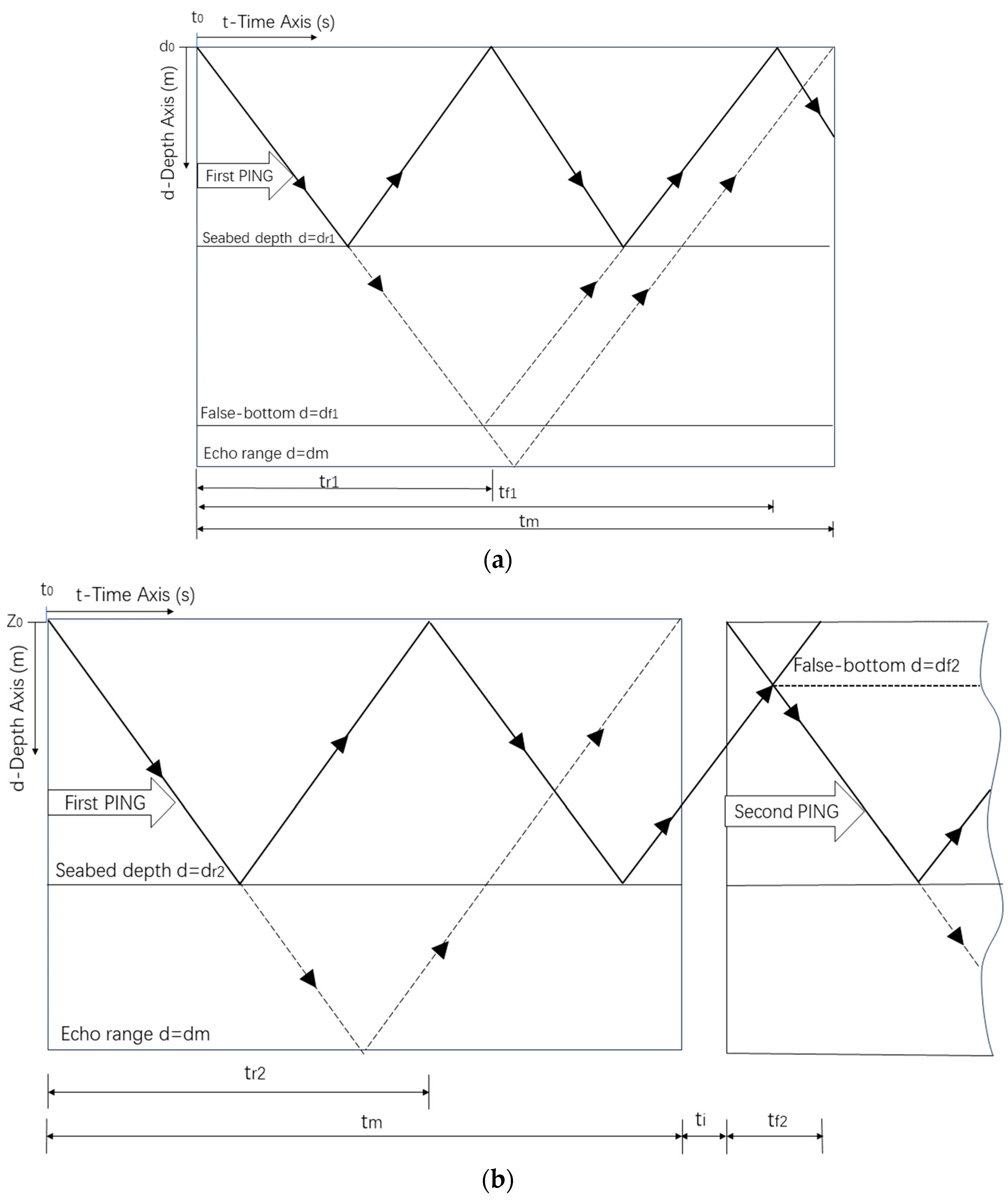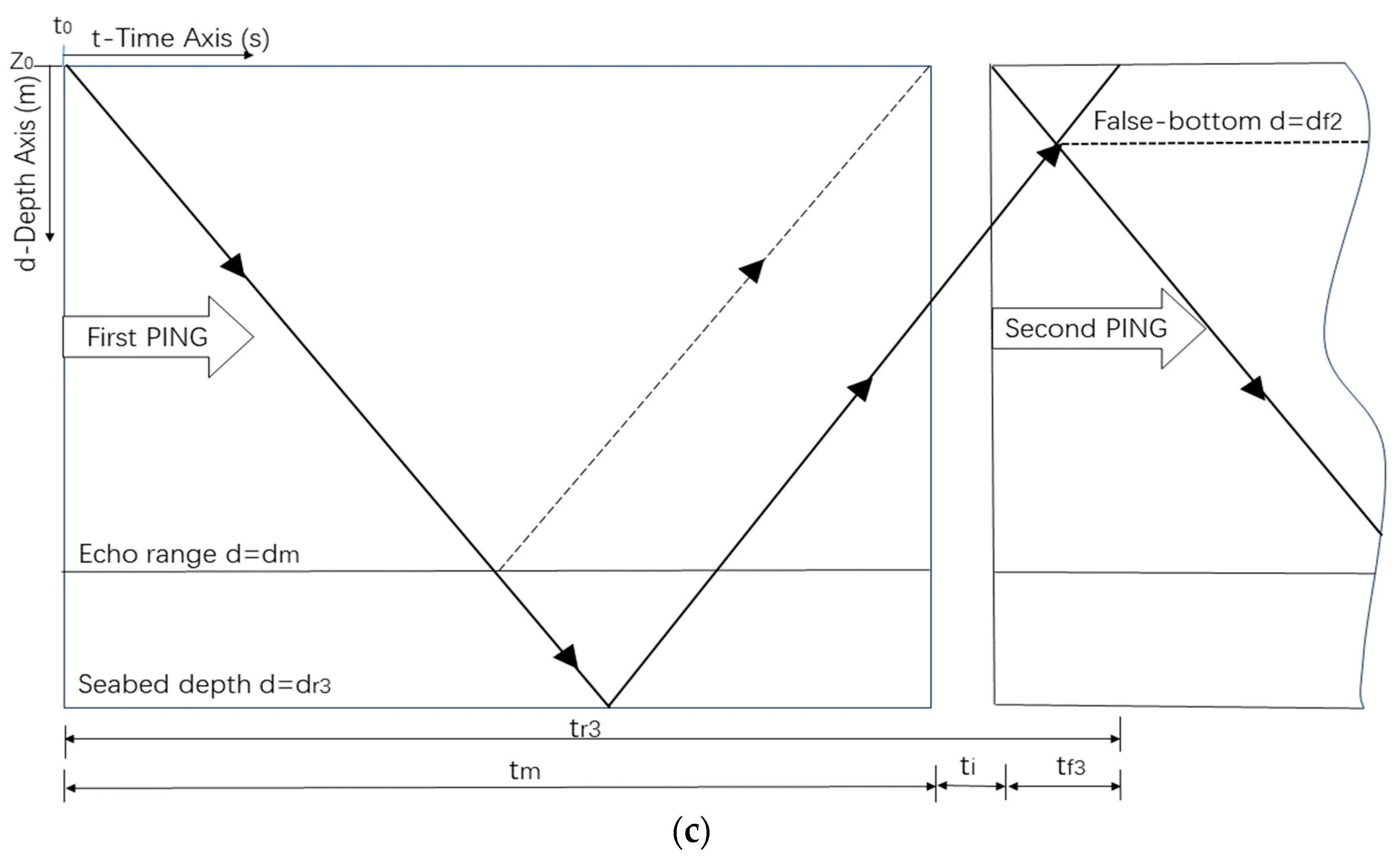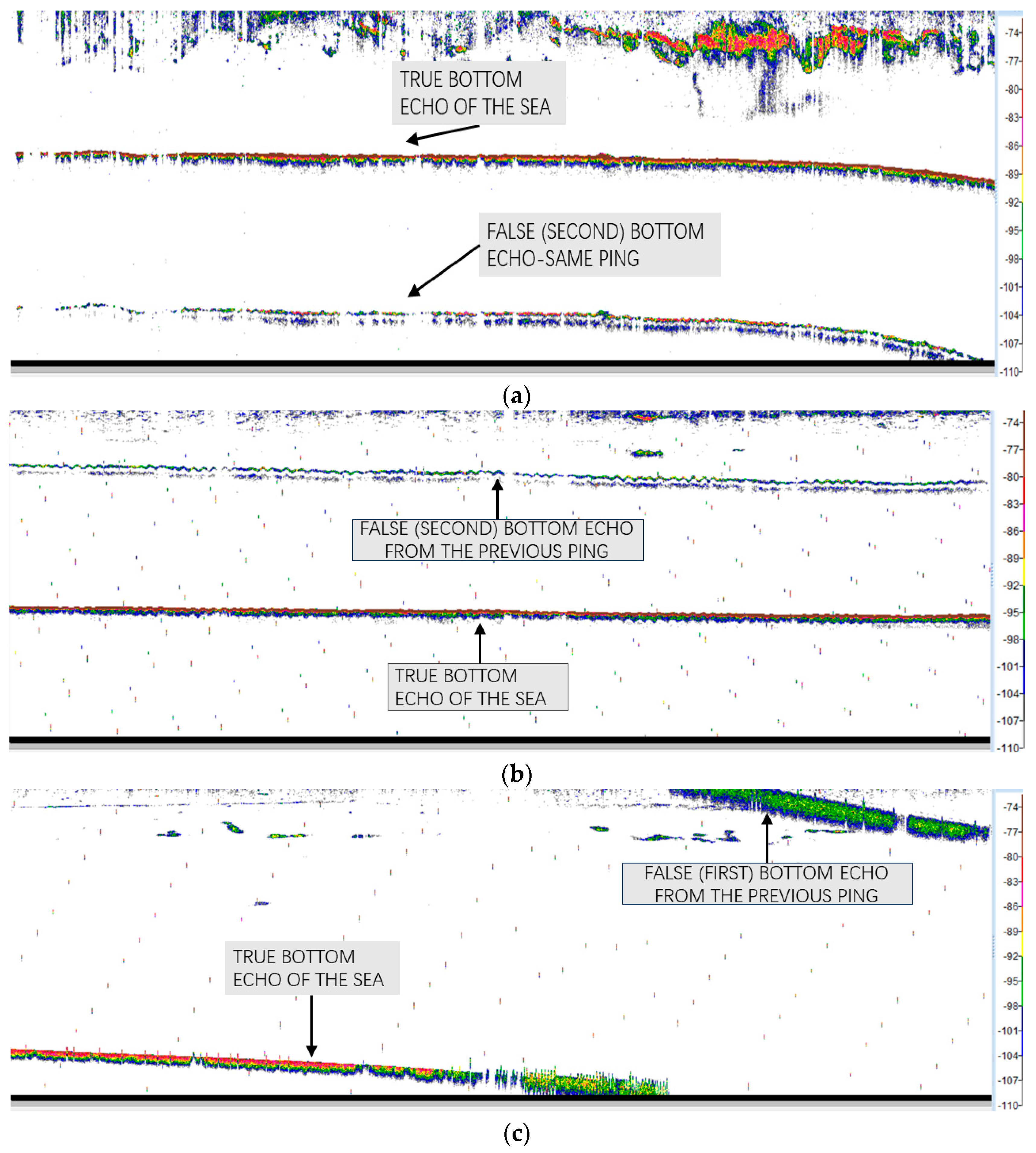Cause Analysis and Preventive Measures against False Bottoms in Echosounder Data
Abstract
1. Introduction
2. Materials and Methods
2.1. Material Sources
2.2. The Working Principle and Imaging Principle of the Echosounder
2.3. The Influence of False Bottoms on Echosounder Detection and Its Causes
2.3.1. The Second Reflection of the Same Ping Signal Forms a False Bottom
2.3.2. The First Ping Echo Signal Is Reflected Twice to Form a False Bottom on the Second Ping
2.3.3. The Bottom Echo Signal Outside the Detection Range of the Previous Ping Forms a False Bottom in the Next Ping
2.4. Verification of the Correctness of the Formula Derivation
3. Results
4. Discussion
4.1. Comparison of High-Frequency and Low-Frequency Signals
4.2. Increasing the Time Interval between Adjacent Signal Reception Cycles
5. Conclusions
Author Contributions
Funding
Data Availability Statement
Acknowledgments
Conflicts of Interest
References
- Naik, M.; Ranade, G.; Lohani, R.B. Evolution of Sonar Survey Systems for Sea Floor Studies. Eng. Technol. J. 2017, 2, 185–195. [Google Scholar] [CrossRef][Green Version]
- Zhang, X.; Heald, G.; Lyons, A.P.; Hansen, R.E.; Hunter, A.J. Guest editorial: Recent advances in synthetic aperture sonar technology. Electron. Lett. 2023, 59, e12881. [Google Scholar] [CrossRef]
- Wu, Y.; Deng, Y.; Zhang, L.; Zhang, Q.; Bao, R. Research on the development of unmanned underwater system detection technology. J. Phys. Conf. Ser. 2022, 2218, 012079. [Google Scholar] [CrossRef]
- Wei, Y.; Duan, Y.; An, D. Monitoring fish using imaging echosounder: Capacity, challenges and future perspective. Fish Fish. 2022, 23, 1347–1370. [Google Scholar] [CrossRef]
- Sánchez-Carnero, N.; Rodríguez-Pérez, D.; Llorens, S.; Orenes-Salazar, V.; Ortolano, A.; García-Charton, J. An expeditious low-cost method for the acoustic characterization of seabeds in a Mediterranean coastal protected area. Estuar. Coast. Shelf Sci. 2023, 281, 108204. [Google Scholar] [CrossRef]
- Shang, X.; Zhao, J.; Zhang, H. Obtaining high-resolution seabed topography and surface details by co-registration of side-scan echosounder and multibeam echo sounder images. Remote Sens. 2019, 11, 1496. [Google Scholar] [CrossRef]
- Bollinger, M.A.; Kline, R.J. Validating sidescan sonar as a fish survey tool over artificial reefs. J. Coast. Res. 2017, 33, 1397–1407. [Google Scholar] [CrossRef]
- Misund, O.A.; Aglen, A.; Frønæs, E. Mapping the shape, size, and density of fish schools by echo integration and a high-resolution sonar. ICES J. Mar. Sci. 1995, 52, 11–20. [Google Scholar] [CrossRef]
- Soria, M.; Fréon, P.; Gerlotto, F. Analysis of vessel influence on spatial behaviour of fish schools using a multi-beam echosounder and consequences for biomass estimates by echo-sounder. ICES J. Mar. Sci. 1996, 53, 453–458. [Google Scholar] [CrossRef]
- Wang, C.; Li, Z.; Wang, T.; Xu, X.; Zhang, X.; Li, D. Intelligent fish farm—The future of aquaculture. Aquac. Int. 2021, 29, 2681–2711. [Google Scholar] [CrossRef]
- Gerlotto, F.; Soria, M.; Fréon, P. From two dimensions to three: The use of multibeam sonar for a new approach in fisheries acoustics. Can. J. Fish. Aquat. Sci. 1999, 56, 6–12. [Google Scholar] [CrossRef]
- He, R.; Dai, Y.; Liu, S.; Yang, Y.; Wang, Y.; Fan, W.; Zhang, S. Application of Wavelet Transform for the Detection of Cetacean Acoustic Signals. Appl. Sci. 2023, 13, 4521. [Google Scholar] [CrossRef]
- Tsai, C.C.; Lin, C.H. Review and Future Perspective of Geophysical Methods Applied in Nearshore Site Characterization. J. Mar. Sci. Eng. 2022, 10, 344. [Google Scholar] [CrossRef]
- Steiniger, Y.; Kraus, D.; Meisen, T. Survey on deep-learning based computer vision for sonar imagery. Eng. Appl. Artif. Intell. 2022, 114, 105157. [Google Scholar] [CrossRef]
- Pose, S.; Reitmann, S.; Licht, G.J.; Grab, T.; Fieback, T. AI-Prepared Autonomous Freshwater Monitoring and Sea Ground Detection by an Autonomous Surface Vehicle. Remote Sens. 2023, 15, 860. [Google Scholar] [CrossRef]
- Blackwell, R.; Harvey, R.; Queste, B.; Fielding, S. Aliased seabed detection in fisheries acoustic data. arXiv 2019, arXiv:1904.10736. [Google Scholar]
- Tomczak, M.; Haffner, G.D.; Fronaes, E. False-bottom acoustic echo in mid water? A note on how to evaluate and prevent the interference. IEEE J. Ocean. Eng. 2002, 27, 870–872. [Google Scholar] [CrossRef]
- Renfree, J.S.; Demer, D.A. Optimizing transmit interval and logging range while avoiding aliased seabed echoes. ICES J. Mar. Sci. 2016, 73, 1955–1964. [Google Scholar] [CrossRef][Green Version]
- Wang, S.X.; Zhang, S.M.; Dai, Y.; Wang, Y.J.; Sui, J.H.; Zhu, W.B. Study on the method of extracting fishing depth of krill using echosounder data. South. Fish. Sci. 2021, 17, 91–97. [Google Scholar]
- Li, Q. Digital Echosounder Design in Underwater Acoustics: Principles and Applications; Springer Science & Business Media: Berlin/Heidelberg, Germany, 2012. [Google Scholar]
- Carter, G.C.; Mehta, S.K.; McTaggart, B.E. Echosounder Systems. In Advanced Signal Processing; CRC Press: Boca Raton, FL, USA, 2017; pp. 381–406. [Google Scholar]
- Yuan, F.; Xiao, F.; Zhang, K.; Huang, Y.; Cheng, E. Noise reduction for echosounder images by statistical analysis and fields of experts. J. Vis. Commun. Image Represent. 2021, 74, 102995. [Google Scholar] [CrossRef]
- Zhang, H.; Cheng, J.; Tian, M.; Liu, J.; Shao, G.; Shao, S. A Reverberation Noise Suppression Method of Echosounder Image Based on Shearlet Transform. IEEE Sens. J. 2022, 23, 2672–2683. [Google Scholar] [CrossRef]
- Wicker, K.; Arens, E. Adaptive compensation of noise in an echosounder system. J. Acoust. Soc. Am. 1999, 105 (Suppl. S2), 973. [Google Scholar] [CrossRef]
- Stolojescu-Crisan, C.; Isar, A. Denoising and inpainting ECHOSOUNDER images. In Proceedings of the 2015 38th International Conference on Telecommunications and Signal Processing (TSP), Prague, Czech Republic, 9–11 July 2015; IEEE: Piscataway, NJ, USA, 2015; pp. 1–5. [Google Scholar]
- Kang, H. Identification of underwater objects using echosounder image. J. Inst. Electron. Inf. Eng. 2016, 53, 91–98. [Google Scholar]
- Tueller, P.; Kastner, R.; Diamant, R. Target detection using features for sonar images. IET Radar Sonar Navig. 2020, 14, 1940–1949. [Google Scholar] [CrossRef]
- Harrison, L.M.K.; Cox, M.J.; Skaret, G.; Harcourt, R. The R package EchoviewR for automated processing of active acoustic data using Echoview. Front. Mar. Sci. 2015, 2, 15. [Google Scholar] [CrossRef]
- Buelens, B.; Pauly, T.; Higginbottom, I. Echoview as a multibeam echosounder data processing and analysis toolkit for fisheries research. J. Acoust. Soc. Am. 2003, 114 (Suppl. S4), 2301. [Google Scholar] [CrossRef]
- Foote, K.G.; Knudsen, H.P.; Korneliussen, R.J.; Nordbo, P.E.; Roang, K. Postprocessing system for echo sounder data. J. Acoust. Soc. Am. 1991, 90, 37–47. [Google Scholar] [CrossRef]
- Liu, B.S.; Huang, Y.W.; Chen, W.J.; Lei, J.Y. Principles of Hydroacoustics, 3rd ed.; Science Press: Beijing, China, 2019; Volume 11, pp. 30–35. [Google Scholar]
- Pierce, A.D. Acoustics: An Introduction to Its Physical Principles and Applications; Springer: Berlin/Heidelberg, Germany, 2019. [Google Scholar]
- Pierce, L. Acoustics; Springer International Publishing: Cham, Switzerland, 2019. [Google Scholar]
- Andersen, L.N. The new Simrad EK60 scientific echo sounder system. J. Acoust. Soc. Am. 2001, 109, 2336. [Google Scholar] [CrossRef]
- Letessier, T.B.; Proud, R.; Meeuwig, J.J.; Cox, M.J.; Hosegood, P.J.; Brierley, A.S. Estimating pelagic fish biomass in a tropical seascape using echosounding and baited stereo-videography. Ecosystems 2022, 25, 1400–1417. [Google Scholar] [CrossRef]
- Langkau, M.C.; Balk, H.; Schmidt, M.B.; Borcherding, J. Can acoustic shadows identify fish species? A novel application of imaging sonar data. Fish. Manag. Ecol. 2012, 19, 313–322. [Google Scholar] [CrossRef]
- Jones, R.E.; Griffin, R.A.; Unsworth, R.K.F. Adaptive Resolution Imaging Echosounder (ARIS) as a tool for marine fish identification. Fish. Res. 2021, 243, 106092. [Google Scholar] [CrossRef]
- Terayama, K.; Shin, K.; Mizuno, K.; Tsuda, K. Integration of sonar and optical camera images using deep neural network for fish monitoring. Aquac. Eng. 2019, 86, 102000. [Google Scholar] [CrossRef]
- Trabant, P.K. Applied High-Resolution Geophysical Methods: Offshore Geoengineering Hazards; Springer Science & Business Media: Berlin/Heidelberg, Germany, 2013. [Google Scholar]
- Bourguignon, S.; Berger, L.; Scalabrin, C.; Fablet, R.; Mazauric, V. Methodological developments for improved bottom detection with the ME70 multibeam echosounder. ICES J. Mar. Sci. 2009, 66, 1015–1022. [Google Scholar] [CrossRef]
- Wang, J.; Li, H.; Ma, J.; Chen, B.; Xing, T.; Zhao, H. Fast double selectivity index-CFAR detection method for the multi-beam echo sounder. Mar. Geod. 2020, 43, 44–62. [Google Scholar] [CrossRef]
- Jiang, Y.; Yang, Z.; Liu, Z.; Yang, C. High-resolution bottom detection algorithm for a multibeam echo-sounder system with a U-shaped array. Acta Oceanol. Sin. 2018, 37, 78–84. [Google Scholar] [CrossRef]
- Brautaset, O.; Waldeland, A.U.; Johnsen, E.; Malde, K.; Eikvil, L.; Salberg, A.-B.; Handegard, N.O. Acoustic classification in multifrequency echosounder data using deep convolutional neural networks. ICES J. Mar. Sci. 2020, 77, 1391–1400. [Google Scholar] [CrossRef]
- Debese, N.; Moitié, R.; Seube, N. Multibeam echosounder data cleaning through a hierarchic adaptive and robust local surfacing. Comput. Geosci. 2012, 46, 330–339. [Google Scholar] [CrossRef]
- Mosca, F.; Matte, G.; Lerda, O.; Naud, F.; Charlot, D.; Rioblanc, M.; Corbières, C. Scientific potential of a new 3D multibeam echosounder in fisheries and ecosystem research. Fish. Res. 2016, 178, 130–141. [Google Scholar] [CrossRef]
- Python-python v3.10 Manual. Available online: https://www.python.org/ (accessed on 10 June 2023).
- Echopype-echopype v0.7.1 Manual. Available online: https://github.com/OSOceanAcoustics/echopype (accessed on 10 June 2023).



| Type | Parameters | Quantity |
|---|---|---|
| First type | Total <2% 2%~5% >5% | 200 195 5 0 |
| Second type | Total <2% 2%~5% >5% | 200 192 6 2 |
Disclaimer/Publisher’s Note: The statements, opinions and data contained in all publications are solely those of the individual author(s) and contributor(s) and not of MDPI and/or the editor(s). MDPI and/or the editor(s) disclaim responsibility for any injury to people or property resulting from any ideas, methods, instructions or products referred to in the content. |
© 2024 by the authors. Licensee MDPI, Basel, Switzerland. This article is an open access article distributed under the terms and conditions of the Creative Commons Attribution (CC BY) license (https://creativecommons.org/licenses/by/4.0/).
Share and Cite
Xiong, X.; He, R.; Fan, W.; Wu, Z.; Yu, S.; Wang, Z.; Wang, Y.; Dai, Y. Cause Analysis and Preventive Measures against False Bottoms in Echosounder Data. Appl. Sci. 2024, 14, 2444. https://doi.org/10.3390/app14062444
Xiong X, He R, Fan W, Wu Z, Yu S, Wang Z, Wang Y, Dai Y. Cause Analysis and Preventive Measures against False Bottoms in Echosounder Data. Applied Sciences. 2024; 14(6):2444. https://doi.org/10.3390/app14062444
Chicago/Turabian StyleXiong, Xinquan, Ruilin He, Wei Fan, Zuli Wu, Shengchi Yu, Zhongqiu Wang, Yongjin Wang, and Yang Dai. 2024. "Cause Analysis and Preventive Measures against False Bottoms in Echosounder Data" Applied Sciences 14, no. 6: 2444. https://doi.org/10.3390/app14062444
APA StyleXiong, X., He, R., Fan, W., Wu, Z., Yu, S., Wang, Z., Wang, Y., & Dai, Y. (2024). Cause Analysis and Preventive Measures against False Bottoms in Echosounder Data. Applied Sciences, 14(6), 2444. https://doi.org/10.3390/app14062444







